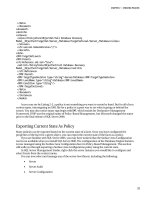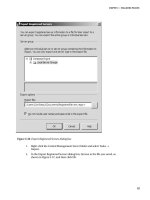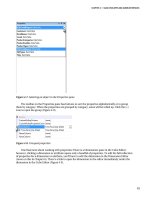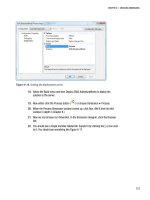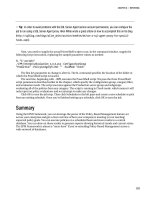Pro SQL Server 2008 Policy-Based Management- P6
Bạn đang xem bản rút gọn của tài liệu. Xem và tải ngay bản đầy đủ của tài liệu tại đây (747.93 KB, 20 trang )
APPENDIX MICROSOFT SQL SERVER BEST PRACTICE POLICIES
233
Windows Event Log I/O Delay
Warning
I/O Delay Warning Check Server
Windows Event Log I/O Error
During Hard Page Fault Error
I/O Error During Hard Page Fault Error Check Server
Windows Event Log Read Retry
Error
Read Retry Error Check Server
Windows Event Log Storage
System I/O Timeout Error
Storage System I/O Timeout Error Check Server
Windows Event Log System
Failure Error
System Failure Error Check Server
Please purchase PDF Split-Merge on www.verypdf.com to remove this watermark.
Please purchase PDF Split-Merge on www.verypdf.com to remove this watermark.
Index
Symbols
#SQLHelp
how #SQLHelp works, 210
A
accessing database see database access
Active Directory’s Group Policy, 1
ActiveX script job steps
CmdExec Rights Secured policy, 216
Address field, Description page
Create New Policy dialog, 20
administrative accounts
Builtin\Administrators login, 197
disabling sa login, 197
security access to, 196–198
advanced conditions, creating, 40–44
Advanced Edit dialog
creating advanced conditions, 41, 42
creating conditions, 15
Data Purity Flag Check condition, 163
Database Free Space policy, 150
SQL Server Agent Is Running condition, 158,
159
Advisory Services, Microsoft, 213
affinity mask
SQL Server policies, 222, 223
Against Targets field, General page
Create New Policy dialog, 18
Alert System page
SQL Server Agent Properties dialog, 118
alerts, 11
configuring SQL Server Agent alerts, 120–
124
creating for all policy violations, 125
ALTER DATABASE command
enabling Service Broker, 110
Analyzer rules, best practice
importing policies, 24, 27
architecture, PBM, 134–136
Asymmetric Key Encryption Algorithm policy,
202, 215, 230
asynchronous processing
On Change: Log Only evaluation mode, 135
auditing servers
best practice audit policies, 206
compliance, 202–206
default trace, 204–206
login auditing, 203–204
SQL Server Audit, 203
SQL Server Default Trace policy, 206
autoclose
Database Auto Close policy, 167, 217
autogrow
Database Free Space policy, 150
File Growth for SQL Server 2000 policy, 220
autoshrink
Database Auto Shrink policy, 50, 167, 168,
217
evaluating single policy on demand, 50
B
Backup and Data File Location policy, 167, 216,
230
backups
Last Successful Backup Date policy, 167, 221
Successful Transaction Log Backup policy,
153–157
Beauchemin, Bob, 208
behavior
policy behavior, 7–8
Best Practice Analyzer rules
importing policies, 24, 27
best practice policies, 2, 149, 167, 215–233
Asymmetric Key Encryption Algorithm, 202,
215, 230
audit, 206
Backup and Data File Location, 216, 230
CmdExec Rights Secured, 198, 216, 230
235
Please purchase PDF Split-Merge on www.verypdf.com to remove this watermark.
INDEX
Central Management Server groups
best practice policies (cont.)
adding servers to, 80–84
conditions and facets, 230–233
creating, 78–80
custom policies, creating, 150
evaluating policies against, 84–86
Data and Log File Location, 216, 230
importing registered servers and groups,
81–84
Database Auto Close/Shrink, 217, 230
Database Collation, 218, 230
registering server to group, 80–81
Database Page Status/Verification, 219, 230
Central Management Servers, 9–10
default trace, 204
creating, 77–78descriptions and HTML links, 215
EPM Framework prerequisites, 169 encryption, 202
evaluating policies using, 76–86
File Growth for SQL Server 2000, 220, 230
PowerShell evaluating policies against, 105–
107
Guest Permissions, 198, 220, 230
Last Successful Backup Date, 167, 221, 230
PowerShell script, EPM, 172
maintenance, 40, 99, 101, 173
registering, 77
Microsoft SQL Server, 215–233
setup script, EPM, 171
Public Not Granted Server Permissions, 198,
221, 231
Change evaluation modes
On Change: Log Only, 7, 49, 67–73
Read-only Database Recovery Model, 221,
231
On Change: Prevent, 7, 50, 74–76
chats
reviewing other policies, 168
Microsoft Technical Communities web site,
212
security, 197, 198–199
SQL Server Default Trace, 206, 223, 231
Check Condition field, General page
SQL Server Login Mode, 198, 224, 231
Create New Policy dialog, 17
SQL Server Password Expiration, 199, 226,
231
Check Number of Databases policy
Create New Condition dialog, 43
SQL Server Password Policy, 199, 226, 232
CHECKDB command, DBCC, 163
SQL Server Xyz, 222–226, 231–232
checklist, DBA, 149
Surface Area Configuration Xyx, 226–227,
232
checksum
Database Page Verification policy, 219
Symmetric Key Xyz, 202, 227, 232
classes
Trustworthy Database, 199, 227, 232
see also objects
Windows Event Log Xyz, 228–229, 232–233
Policy.Name class, SMO, 92
BIDS (Business Intelligence Developer Studio),
175
SQLStoreConnection class, 92
CmdExec Rights for sysadmins Only condition,
198
blocked process threshold
SQL Server Blocked Process Threshold
policy, 222 CmdExec Rights Secured policy, 198, 216, 230
cmdletsblogs
Get-Member, 93
DBA resources, 208
Invoke-PolicyEvaluation, 95, 97
Microsoft Technical Communities web site,
212
CodePlex
EPM download, 169
Builtin\Administrators login, 197
collation
Database Collation policy, 218
C
communities
Microsoft Technical, 212
categories see policy categories
SQL Server, 208, 210
Categories dialog, 40
compliance, 185–186
Category field, Description page
auditing servers, 202–206
Create New Policy dialog, 19
encryption, 199–202
security, 195–199
236
Please purchase PDF Split-Merge on www.verypdf.com to remove this watermark.
INDEX
syspolicy_configuration_internal table, 139
server configuration, 188–195
ConfigurationGroup parameter
log retention, 191–193
PowerShell script, EPM, 172
SQL Server service account, 189–191
Configure SQL Server Error Logs dialog, 191,
192
Surface Area Configuration facet, 194–
195
Connection Properties dialog, 178
viewing EPM Framework reports, 180
context-sensitive help
Compliance Guide white paper, 209
SQL Server Books Online, 211
compliance regulations, 186–188
Create New Category dialog, 38
Gramm-Leach-Bliley Act (GLBA), 186
Create New Condition dialog, 13, 14, 15
Health Insurance Portability and
Accountability Act (HIPAA), 187
creating advanced conditions, 41, 43
Create New Policy dialog
Payment Card Industry Data Security
Standard (PCI DSS), 187
Description page, 9, 18, 19
General page, 16, 17, 20
Sarbanes-Oxley Act (SOX), 187
Credentials option
components, PBM, 3–6
Shared Data Source Properties dialog, 178
conditions
credit card data
All SQL Server Agent Jobs Have Notification
on Failure, 162
PCI DSS, 187
custom policies, 150–164
Check Condition field, Create New Policy
dialog, 17
Data Purity Flag Enabled, 163–165
Database Free Space, 150–152
creating, 13–16
SQL Server Agent is running, 158–160
advanced conditions, 40–44
SQL Server Agent Jobs have notification on
failure, 160–162
Data Purity Flag Enabled, 163, 164, 165
Database Auto Shrink policy, 168
Successful Transaction Log Backup, 153–
157
Database Free Space, 151
Database Has Less than 10 Pct Free Space,
150
Databases in Full or Bulk Logged, 154, 155,
156
D
defining for system databases, 44–47
Dashboard report, EPM, 179, 180
description, 5
Data and Log File Location policy, 216, 230
determining all policies using, 22
importing policies, 25
Log Backup More than 15 Minutes Old, 153,
154
data encryption see encryption
data files
Microsoft SQL Server best practice policies,
230–233
Backup and Data File Location policy, 167,
216
Open Condition dialog, 5
Data and Log File Location policy, 216
SQL Agent Jobs with No Notification on
Failure, 161
Data Purity Flag Enabled condition, 163
DATA_PURITY check
SQL Server Agent Is Running, 158–160
DBCC CHECKDB command, 163
Successful Transaction Log Backup, 156
database access
syspolicy_conditions view, 141
Guest Permissions policy, 220
syspolicy_conditions_internal table, 138
managing security permissions, 195
confidential information
PCI DSS, 188
Sarbanes-Oxley Act (SOX), 187
Database Auto Close policy, 167, 217, 230
configuration
Database Auto Shrink policy, 50, 167, 168, 217,
230
protecting against unauthorized changes, 2
server configuration for compliance, 188–
195
Database Collation policy, 218, 230
Database Engine Eventing, 135
Surface Area Configuration facet, 194–195
Database facet, properties of, 4
syspolicy_configuration view, 142
237
Please purchase PDF Split-Merge on www.verypdf.com to remove this watermark.
INDEX
SQL Server web sites, 207, 212
Database Free Space condition, 151
training events, 209
Database Free Space policy, 150–152
user groups, 212
Database Mail
webcasts, 211, 212
adding profile, 110
white papers, 208
associating account with profile, 110
DBA Support operator, 117
checking error logs, 112
DBAs
cleaning up history, 113–114
reasons for using PBM, 1
configuring, 109–114
DBCC CHECKDB command, 163
deleting all Database Mail log entries, 113
Declarative Management Framework (DMF),
33
receiving alert notifications for policy
violations, 109
see also Policy-Based Management
setup script, 111
Declarative Management white paper, 209
testing Database Mail, 111–113
default trace, 204–206
Database Maintenance
SQL Server Default Trace policy, 223
creating conditions, 14
defragmentation
database owner (dbo)
Windows Event Log Disk Defragmentation
policy, 228
subscribing to categories, 39
Database Page Status policy, 219, 230
Demand evaluation mode, On, 7, 49, 50–60
Database Page Verification policy, 219, 230
evaluating multiple policies, 55–57
databases
evaluating policies against different
instance, 57–60
Data Purity Flag Enabled, 163–165
Database Free Space policy, 150–152
evaluating single policy, 50–54
DBA checklist, 149
Dependent Conditions page
defining conditions for system databases,
44–47
Facet Properties - Database dialog, 4
dependent policies
evaluating policies against different
instance, 57–60
deleting condition with, 22
viewing, 21–23
Facet Properties - Database dialog, 4
Dependent Policies page
SQL Server Agent Is Running condition,
158–160
Facet Properties - Database dialog, 4
Open Condition dialog, 5, 21
SQL Server Agent jobs have notification on
failure policy, 160–162
Description field, Description page
Create New Policy dialog, 19
Successful Transaction Log Backup policy,
153–157
Description page
Create New Condition dialog, 15
Surface Area Configuration Xyz policies, 226
Create New Policy dialog, 18, 19
Symmetric Key Xyz policies, 202, 227
Create Policy dialog, 9
Trustworthy Database policy, 199, 227
Open Condition dialog, 5
Databases in Full or Bulk Logged condition, 156
Open Policy dialog, 6, 27
Davidson, Tom, 101, 169
creating policy categories, 38, 39
DBA checklist, 149
DFM namespace, 92
DBA Mail Account/Profile, 110
dialog boxes
DBA resources, 207–213
Advanced Edit, 15, 41, 42
blogs, 208, 212
Categories, 40
forums, 212
Configure SQL Server Error Logs, 191, 192
Microsoft paid support options, 212
Connection Properties, 178
Microsoft support, 211–213
Create New Category, 38
newsgroups, 212
Create New Condition, 13
podcasts, 209
Create New Policy, 16, 20
social networking, 210
Evaluate Policies, 51, 53, 54, 55, 85, 86, 87
SQL Server Books Online, 211
SQL Server community, 210
238
Please purchase PDF Split-Merge on www.verypdf.com to remove this watermark.
INDEX
encryption
evaluating multiple policies on demand,
56
best practice policies, 202
compliance, 199–202
evaluating policies against different
instance, 58
transparent data encryption, 199–200
encryption keys
evaluating single policy on demand, 51
Asymmetric Key Encryption Algorithm
policy, 202, 215
Export as Policy, 35
Export Policy, 28
Extensible Key Management, 201–202
Export Registered Servers, 82, 83
managing, 201Facet Properties - Database, 4
Symmetric Key policies, 202, 227 Import, 24
EncryptionEnabled property, Database facet,
199
Import Registered Servers, 83, 84
Job Properties, 123
Enterprise Policy Management see EPM
Job Step Properties, 113, 182
Enterprise Support web site, 213
Log File Viewer, 72
entity relationship diagram, PBM, 138
Login Properties, 71
EPM (Enterprise Policy Management), 169–183
Manage Policy Categories, 9, 37, 38, 174
EPM Framework, 10
New Alert, 122
automating, 182–183
New Job, 123
downloading, 169
New Job Schedule, 63, 64
viewing reports, 179–181
New Operator, 116
white paper, 209
New Server Group Properties, 79, 80
EPM Framework, setting up, 170–179
New Server Registration, 77, 78, 80, 81
PowerShell script, 170, 171–175
Open Condition, 5, 21
Reporting Services reports, 170, 175–179
Open Policy, 6, 26
setup script, 170–171
adding policies to existing schedule, 66
error logs
creating schedules, 61, 63, 64, 65
configuring log retention for SQL Server,
191–193
Operator Properties, 123
Pick Schedule for Job, 66
script returning number retained by SQL
Server, 192
Policy Management Properties, 131, 132
PolicyReports Property Pages, 175
error numbers
Properties, 61
policy violations, 121
Results Detailed View, 44, 51, 52
errors
Select Policy, 24, 25
checking error logs, Database Mail, 112
Select Source, 59, 85
deleting condition with dependent policies,
22, 23
Send Test E-Mail, 111
Server Properties, 203, 204
EvalMode parameter
Shared Data Source Properties, 177, 179
PowerShell script, EPM, 174
SQL Server Agent Properties, 118
Evaluate Policies dialog
View Facets, 34, 199, 200, 201
evaluating policies
View Policies, 128, 129
against Central Management Server
group, 85, 86, 87
dynamic locks
SQL Server Dynamic Locks policy, 223
against different instance, 58
multiple policies on demand, 56
E
single policy on demand, 51, 53, 55
Evaluation Results page, 51, 56
Policy Selection page, 56, 58
deleting all e-mail messages, 113
script options in, 54
Send Test E-Mail dialog, 111
warning flag for policies containing scripts,
56
Enabled property
Policy Management Properties dialog, 132
evaluating policies see under policies
239
Please purchase PDF Split-Merge on www.verypdf.com to remove this watermark.
INDEX
Expression field, General page
Evaluation Mode field, General page
Create New Condition dialog, 14
Create New Policy dialog, 18
Extensible Key Management, 201–202
evaluation modes, 7–8, 49–50
ExtensibleKeyManagementEnabled property
availability of, 49
Server Configuration facet, 201
On Change: Log Only, 7, 49, 67–73
On Change: Prevent, 7, 50, 74–76
On Demand, 7, 49, 50–60
F
evaluating multiple policies, 55–57
evaluating against other instance, 57–
60
Facet field, General page
Create New Condition dialog, 14
evaluating single policy, 50–54
Facet Properties - Database dialog, 4
On Schedule, 7, 49, 60–67
facets, 4
adding policies to schedule, 66–67
best practice policies, 230–233
creating schedules, 61–65
creating advanced conditions, 41
Evaluation Results page, Evaluate Policies
dialog
exporting current state as policy, 33–35
managing facets, 34
evaluating multiple policies on demand,
56
Policy Management Properties, 134
Server Configuration facet, 201
evaluating single policy on demand, 51
server-level facets, 33
Results section, 53
Surface Area Configuration facet, 194–195
Target Details section, 51
syspolicy_facet_events table, 139
Event Alert Definition area
syspolicy_management_facets table, 139
configuring SQL Server Agent alerts, 122
Failed Policy Xyz reports, 181
event logs
fail-safe operator
On Change: Log Only evaluation mode, 49,
67–73
SQL Server Agent notifications, 118
fiber mode
policy violation shown in, 120, 121
SQL Server Lightweight Pooling policy, 223
Windows Event Log Xyz policies, 228, 229
File Growth for SQL Server 2000 policy, 220, 230
events
file system
configuring SQL Server Agent alerts, 120
adding policies to Invoke-PolicyEvaluation
cmdlet, 98
syspolicy_facet_events table, 139
ExecuteSql function, 41, 44
searching for policy category on, 98, 99
check for Builtin\Administrators login,
197
Files to Import field, Import dialog, 24
filters
configuring log retention for SQL Server,
193
PolicyCategoryFilter parameter, 173
reasons why policy not execute as expected,
129
ensuring sa login disabled, 198
PBM security, 136, 137
financial information compliance
server configuration for compliance,
190
Gramm-Leach-Bliley Act (GLBA), 186
financial reporting compliance
ExecuteWql function, 41
Sarbanes-Oxley Act (SOX), 187
execution modes
fn_syspolicy_is_automation_enabled function,
136
policy violation error numbers, 121
Export as Policy dialog, 35
forums
Export Policy dialog, 28
Microsoft Technical Communities, 212
Export Registered Servers dialog, 82, 83
frameworks
exporting policies, 27–35
Declarative Management, 33
existing policies, 28–33
Enterprise Policy Management, 10
exporting current state of facet as policy,
33–35
free space
Database Free Space policy, 150–152
multiple policies, 28
240
Please purchase PDF Split-Merge on www.verypdf.com to remove this watermark.
